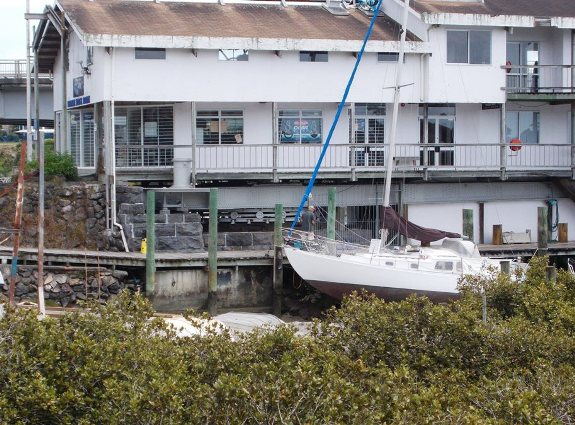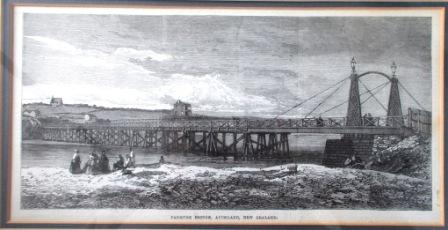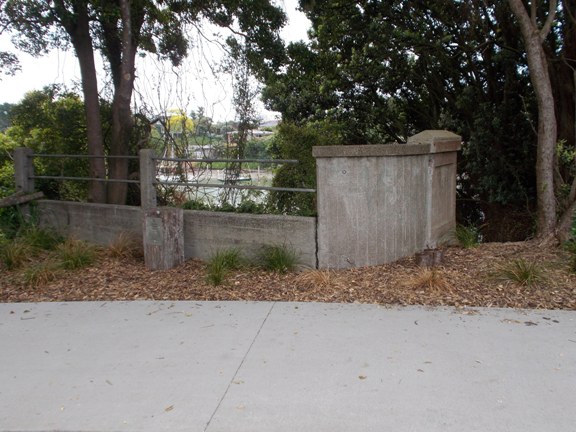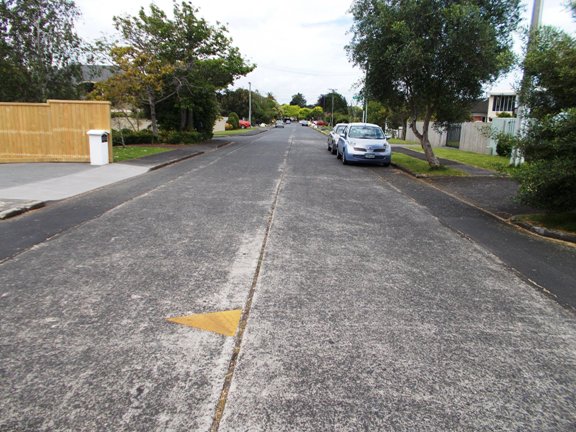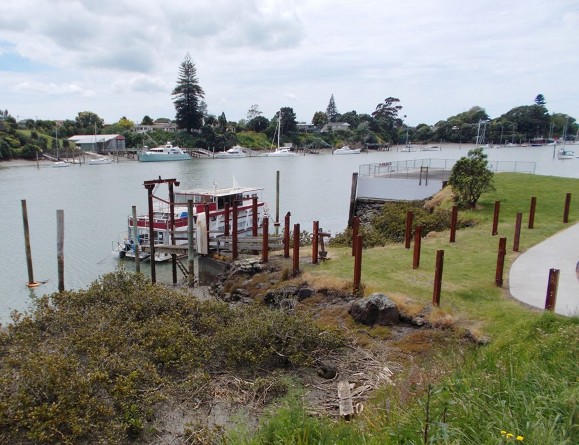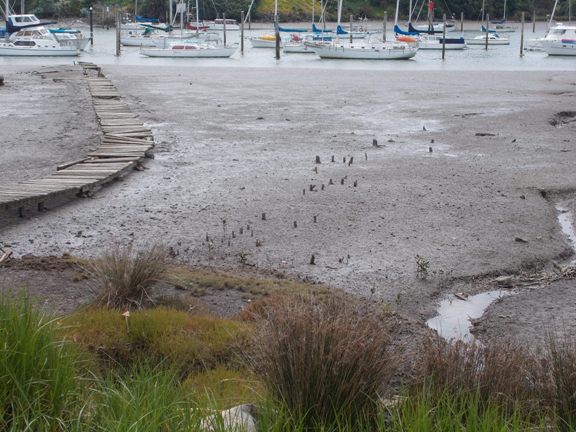Difference between revisions of "Tamaki River Narrows Sites - Visit"
| (17 intermediate revisions by the same user not shown) | |||
| Line 29: | Line 29: | ||
== What: == | == What: == | ||
| − | An assemblage of related sites concentrating on the narrowest section of the Tamaki River - a tidal channel on Auckland's eastern side. | + | An assemblage of related sites concentrating on the narrowest section of the Tamaki River - a tidal channel on Auckland's eastern side. The narrow section of the river made is attractive as a site for bridges - there is still one here today, and the proximity of deeper water to the shore for more modern landing facilities. Nearby today there are still slipways and boat construction yards. There are interpretive signs along the [http://www.aucklandtransport.govt.nz/moving-around/walking-footpaths/MapsAndMore/Pages/PakurangaRotaryWalkway.aspx Rotary Walkway]. |
| + | ---- | ||
| + | ===First Bridge 1865=== | ||
{| | {| | ||
| − | | | + | |This early piece of Auckland engineering replaced a ferry. The first bridge here survives in part - and was recently restored. The part surviving is a swinging section sitting on a turntable with a geared turning mechanism. The turntable can be seen on the bluestone abutment to the left of the bow of the yacht. The swinging section of the bridge had a building on it show in the photo that has since been removed. |
| − | + | ||
| − | |||
| − | |||
|[[File:Bridge1.jpg|framed|The remaining section of the first bridge.]] | |[[File:Bridge1.jpg|framed|The remaining section of the first bridge.]] | ||
|- | |- | ||
| − | | | + | |[[File:Panmuresm.jpg|framed|The first bridge as pictured in the London Illustrated News]] |
| − | | | ||
|} | |} | ||
| − | |||
| − | |||
| − | + | ---- | |
===Second Bridge 1916=== | ===Second Bridge 1916=== | ||
| + | {| | ||
| + | |The second bridge replaced the first. It was early reinforced concrete but poorly built and quickly became a concern for its safety. It was demolished in 1963 after the third and existing bridge was built. All that remains are these abutment wing walls. | ||
| + | |[[File:Bridge2x.jpg|framed|The abutment wing walls of the second bridge.]] | ||
| + | |- | ||
| + | |} | ||
| − | + | ---- | |
===Concrete Road 1931=== | ===Concrete Road 1931=== | ||
| + | {| | ||
| + | |In the late 1920s and early 30s a series of concrete surfaced roads were built across Auckland from Titirangi to Howick subsidised by the National Roads Board. It took rare co-ordination by Auckland's many local authorities to achieve this. The Panmure sections linked to the second Tamaki bridge. The roads mostly still exist but typically are now surfaced with asphalt and their ongong contribution unappreciated. The section of road in Kerswill Place is a rare and visible exception, formerly ending at the second bridge, but now just a suburban street. The new concrete road to Howick was opened in 1931. [http://paperspast.natlib.govt.nz/cgi-bin/paperspast?a=d&cl=search&d=AS19310124.2.90&srpos=7&e=--1919---1945--10-AS-1----0concrete+road+howick-- Papers Past] | ||
| + | |[[File:Concroad.jpg|framed|The concrete road in Kerswill Place.]] | ||
| + | |- | ||
| + | |} | ||
| − | + | ---- | |
===Landing Places=== | ===Landing Places=== | ||
| + | {| | ||
| + | |In the foreground is a landing ramp and cattle yard once used to barge cattle to and from Great Barrier Island by the Subritzky Shipping Company. In the background a landing jetty built by the American forces in WW2 to move goods to and from adjacent storage facilities. | ||
| + | |[[File:Wharf.jpg|framed|The two landing places.]] | ||
| + | |- | ||
| + | |} | ||
| − | + | ---- | |
| − | |||
===Fish Trap Stakes?=== | ===Fish Trap Stakes?=== | ||
| − | + | {| | |
| − | [[File:Trap.jpg|framed|Possible Maori fish trap.]] | + | |Stakes - (or are they mangrove roots?) - perhaps the remains of a Maori fish trap. |
| + | |[[File:Trap.jpg|framed|Possible Maori fish trap.]] | ||
| + | |- | ||
| + | |} | ||
== Web Info: == | == Web Info: == | ||
The first bridge has an IPENZ heritage register listing - http://www.ipenz.org.nz/heritage/itemdetail.cfm?itemid=2336 | The first bridge has an IPENZ heritage register listing - http://www.ipenz.org.nz/heritage/itemdetail.cfm?itemid=2336 | ||
| − | + | == Other Sites: == | |
| + | The most famous site in the area is, or was, Mokoia Pa on the site of the north end of the modern bridge. There is nothing now there to be seen so it is not a site to visit. It was a Ngati Paoa pa attacked and taken by Hongi Hika in 1821. | ||
[[Category:Auckland_Sites_to_Visit]] | [[Category:Auckland_Sites_to_Visit]] | ||
Latest revision as of 16:54, 9 December 2022
Contents
Tamaki River Narrows Sites
| SITE TO VISIT | |
|---|---|
| Tamaki River Narrows Sites | |
| - | |
| | |
| | |
| Ethnicity: | European |
| Site type: | Bridges and maritime features |
| Where: | East side of the Tamaki River at Panmure |
| How to get there: | Park in Kerswill Place - use the Rotary walkway. |
| How Long to allow: | 45 minutes. |
| Disclaimer | |
Location:
What:
An assemblage of related sites concentrating on the narrowest section of the Tamaki River - a tidal channel on Auckland's eastern side. The narrow section of the river made is attractive as a site for bridges - there is still one here today, and the proximity of deeper water to the shore for more modern landing facilities. Nearby today there are still slipways and boat construction yards. There are interpretive signs along the Rotary Walkway.
First Bridge 1865
| This early piece of Auckland engineering replaced a ferry. The first bridge here survives in part - and was recently restored. The part surviving is a swinging section sitting on a turntable with a geared turning mechanism. The turntable can be seen on the bluestone abutment to the left of the bow of the yacht. The swinging section of the bridge had a building on it show in the photo that has since been removed. | |
Second Bridge 1916
| The second bridge replaced the first. It was early reinforced concrete but poorly built and quickly became a concern for its safety. It was demolished in 1963 after the third and existing bridge was built. All that remains are these abutment wing walls. |
Concrete Road 1931
| In the late 1920s and early 30s a series of concrete surfaced roads were built across Auckland from Titirangi to Howick subsidised by the National Roads Board. It took rare co-ordination by Auckland's many local authorities to achieve this. The Panmure sections linked to the second Tamaki bridge. The roads mostly still exist but typically are now surfaced with asphalt and their ongong contribution unappreciated. The section of road in Kerswill Place is a rare and visible exception, formerly ending at the second bridge, but now just a suburban street. The new concrete road to Howick was opened in 1931. Papers Past |
Landing Places
| In the foreground is a landing ramp and cattle yard once used to barge cattle to and from Great Barrier Island by the Subritzky Shipping Company. In the background a landing jetty built by the American forces in WW2 to move goods to and from adjacent storage facilities. |
Fish Trap Stakes?
| Stakes - (or are they mangrove roots?) - perhaps the remains of a Maori fish trap. |
Web Info:
The first bridge has an IPENZ heritage register listing - http://www.ipenz.org.nz/heritage/itemdetail.cfm?itemid=2336
Other Sites:
The most famous site in the area is, or was, Mokoia Pa on the site of the north end of the modern bridge. There is nothing now there to be seen so it is not a site to visit. It was a Ngati Paoa pa attacked and taken by Hongi Hika in 1821.
